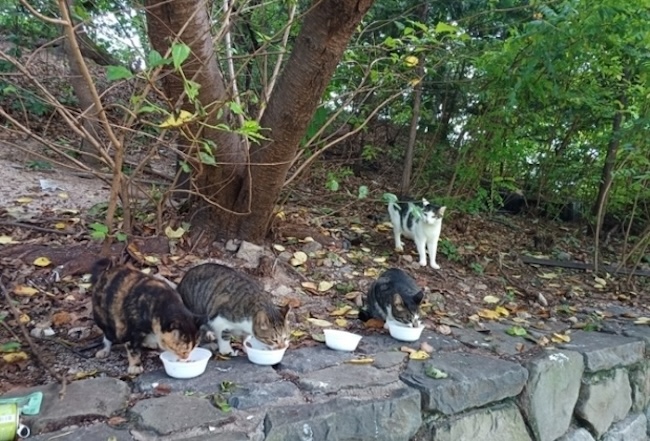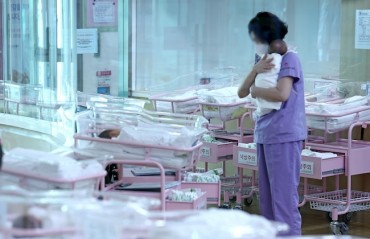
After the post went up on DCInside, four of the five cats died or went missing. (Image courtesy of Kang Seung-hee)
SEOUL, Jan. 31 (Korea Bizwire) – On the morning of December 2, a mackerel-patterned cat named Deungo was found lifeless in Seoul’s Gangbuk District, within the Dream Forest park. The first to discover the grim scene was 51-year-old Kang Seung-hee, who had been feeding the local stray cats for about a decade.
For Kang, it was shocking to find Deungo dead without any prior symptoms. The cat showed no signs of bleeding, diarrhea, or vomiting and appeared to have died in its sleep inside a makeshift shelter created to protect it from the cold.
The sadness was compounded when Euni, a calico cat that got along well with Deungo, also started showing signs of weakness, staggering more than the day before. Another cat from their group, Kkaenip, was nowhere to be found.
The next day, neither Kkaenip nor Euni appeared. Kang’s search led to a hidden manhole cover under fallen leaves where Eunie was found gasping for breath. Rushed to the vet, Eunie was diagnosed with acute renal failure, suspected to be from ingesting a toxic substance, and passed away the following morning.
Kang suspected that Kkaenip might have also hidden away, suffering from similar symptoms before dying.
About a month before these tragic events, a post titled “Cat Moms Spreading Cat Flea Food in Dream Forest” surfaced on the DCInside “Yaongi Gallery,” an online community. The term “cat flea” is derogatory slang used by those who disdain stray cats.
Upon hearing about this post, Kang couldn’t help but feel anxious. The community was known for its extreme content, including videos of cats being burned alive and discussions on killing or abusing stray cats.
To prevent any potential harm to the cats, Kang and acquaintances started patrolling the area, driven by a vague fear that someone might harm them. When Deungo and Euni suddenly died, it seemed their fears were warranted.
Kang sought the assistance of the animal rights group KARA to report the incident to the police and requested autopsies for Deungo and Euni to determine the exact cause of death.
On December 13, while awaiting the autopsy results, Kang noticed Geumbi, a yellow-striped cat that usually just ate and left, sitting quietly on top of the shelter. The remaining cats, Chili and Geumbi, appeared depressed after the loss of their companions. Geumbi, usually wary and aloof, seemed to be comforting Chili.
Later that day, Kang received a call about Geumbi showing the same symptoms as Euni. Geumbi was taken to the vet but also succumbed to the illness, with test results mirroring Euni’s.
The autopsy results from the Animal and Plant Quarantine Agency revealed that Deungo and Euni had ethylene glycol in their systems, a component of antifreeze used in car coolants. This substance was also found in Geumbi’s body and the remnants of food sent for testing.
Antifreeze, known for its sweet taste but deadly consequences, can cause symptoms like vomiting, weakness, metabolic acidosis, acute renal failure, seizures, coma, and respiratory failure in cats. Even a minimal amount can be lethal.
Kang recalled finding torn pieces of cat treat wrappers near the site where the bodies were discovered, items she had never seen in the area before.
Incidents of antifreeze poisoning are not isolated, with similar cases reported across South Korea and in other countries. Despite its deadly nature, antifreeze is readily available for purchase without significant restrictions, posing a threat to pets and wildlife.
The call for safer alternatives or additives to antifreeze, like denatonium benzoate, which has an extremely bitter taste to prevent accidental ingestion, has been growing among veterinarians and animal welfare advocates.
Following the publicization of the incident, some online communities reacted negatively, with some even glorifying the perpetrator. The challenge remains in tracking and penalizing those responsible for such cruel acts, given the difficulty in gathering direct evidence and the ease with which antifreeze can be misused.
Kang, mourning the loss of the cats, hopes for justice to prevent further tragedies and emphasizes the importance of vigilance and protective measures within the community to safeguard the remaining and future stray animals.
Lina Jang (linajang@koreabizwire.com)







Thank you for giving me the opportunity to comment, in my opinion and I believe that this opinion is shared by thousands if not tens of thousands that ethylene glycol antifreeze should be banned. This highly poisonous substance is killing thousands of innocent animals and could be replaced by propylene glycol antifreeze which is far less toxic at the very least a bittering agent such as denatonium benzoate could be added to ethylene glycol antifreeze to make it less appealing.
From what I can see petitions do absolutely no good whatsoever. The only course of action. I could see, is for a peaceful protest.
Sincerely Daniel Theriault